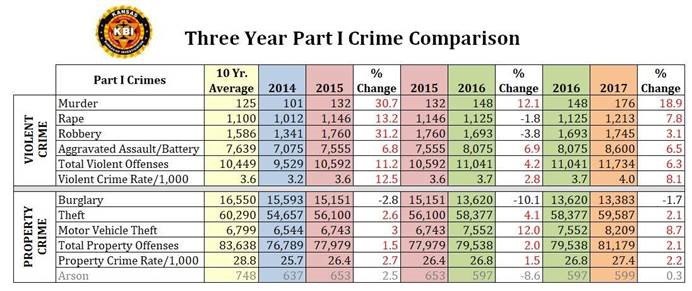KBI releases Kansas crime statistics for 2017
Posted:
Topeka – The Kansas Bureau of Investigation (KBI) has released the 2017 Kansas Crime Index Report. The report compiles crime statistics reported to the KBI by state and local law enforcement agencies across Kansas.
Violent Crime Analysis
The 2017 Kansas Crime Index Report reflected that violent crime in Kansas continues to trend upward. 2017 saw an overall increase of 6.3% in violent crime such as murder, rape, robbery, and aggravated assault and battery. In the past three years, Kansas experienced a 23.1% increase in violent crime. The violent crime rate is currently 12.3% above the 10-year average.
Additionally, 176 murders occurred in 2017, which represents an 18.9% increase over the number of murders committed in 2016. The murder rate is the highest in the past 10 years, and 40.8% above the 10-year average.
The frequency of incidents involving multiple murder victims also increased in 2017, at 21.1%. Identifying common circumstances in murder cases is difficult as 21% were reported as unknown, and 21.7% indicated an unknown suspect. Domestic violence murders comprised 22.3% of the total cases, while arguments were reported in 21.7%. Gang activity was a factor in 11.4% of incidents, and drug dealing was a factor in 10.9%.
In 2017, 1,213 rapes were reported in Kansas, representing a 7.8% increase over 2016. This is 10.3% above the 10-year average.
Property Crime Analysis
According to the 2017 crime report, total property crimes in Kansas declined by 2.1%. However, the property crime figures in this report do not include the numerous cyber crimes which occurred in our state. The FBI’s Internet Crime Complaint Center received 1,767 reports from Kansans victimized in 2017, indicating over $5 million in losses from cyber crimes and other internet facilitated criminal activity.








